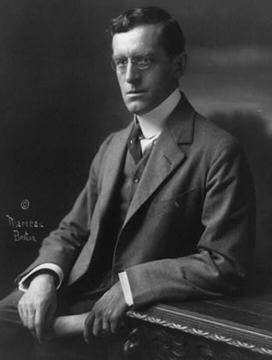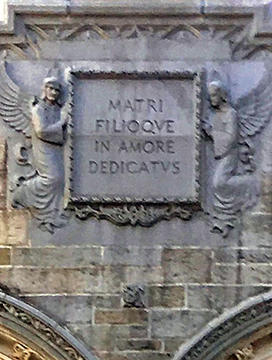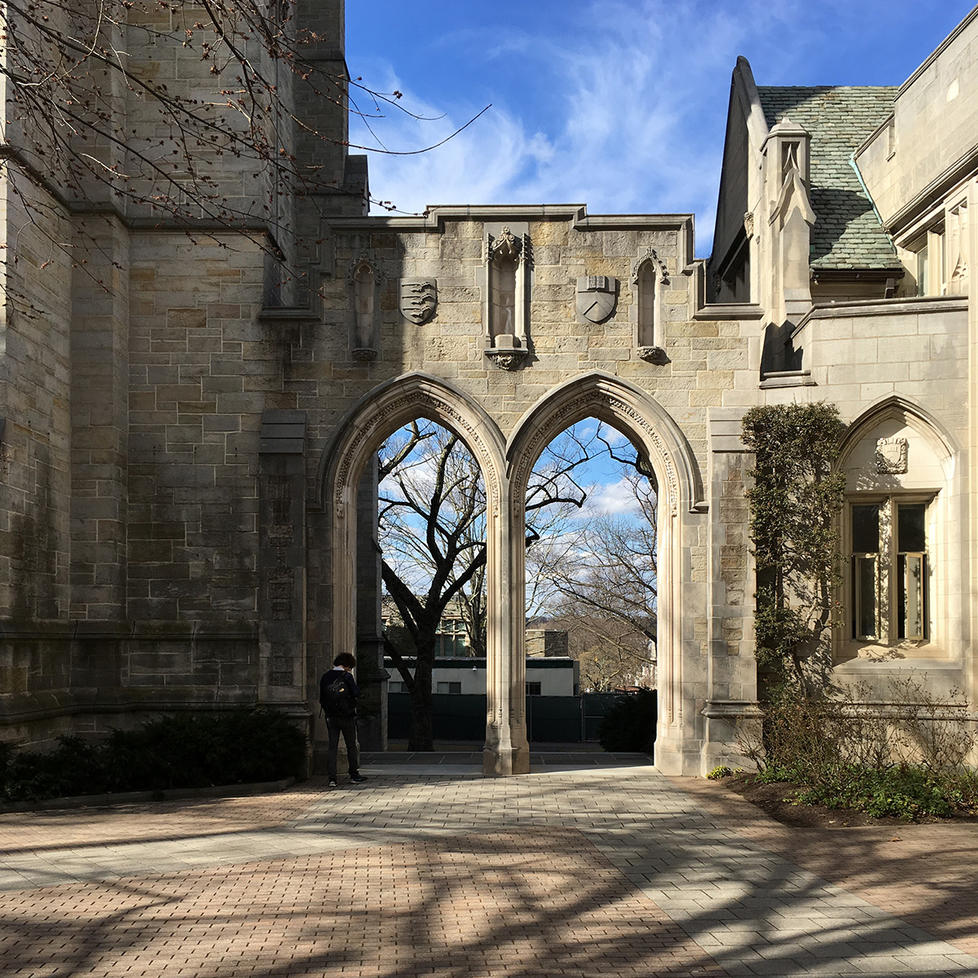A cathedral, a storm wave, a dancer’s leap, never turn out to be as high as we had hoped.
— Marcel Proust
In the off-chance you’ve been touring the Galapagos or Alpha Centauri, out of communication range for the last couple years, it may trouble you to realize that history is not solely the province of nice people. And while the kindly folks may be more pleasing to cogitate on, we must consider the entire range of movers and shakers as we strive to understand how things got this way, not to mention how to get things to be even better in the future. As current events seem to offer limited instructional upside, as they say in the MBA world, perhaps we’d better consider some lessons today from a century or so back, when men were men, buildings were Gothic, and egos were already so convoluted you needed an arbitrator to seat people at a dinner party.
Which brings us to Ralph Adams Cram. (Note to self: When anybody from Boston makes a point of always using “Adams” in his name, watch out.) Admittedly, his era (1863-1942) was that of big shoulders, gigantic expansion of the American dream, and bigger-than-life characters from Boss Tweed to Teddy Roosevelt to Black Jack Pershing; even a bucolic, seemingly ordered place like Princeton had its dominant personalities such as education revolutionary Woodrow Wilson 1879, marketer-cum-Graduate School dean Andrew Fleming West 1874, wealthy trustee Moses Taylor Pine 1877, ex-president and Jersey boy Grover Cleveland, New York socialite and landscape genius Beatrix Farrand, and president and auto-industry foe Rev. John Grier Hibben 1882 *1893. Cram ran across them all in his term as the University’s first consulting architect from 1907 to 1929, and there’s no sign that any of them had the slightest effect on his grand visions for the campus.

In fact, it’s very likely that Cram’s final project at Princeton, including that last catty missive, may be the perfect illustration of the personal traits that dominated his tenure at a crucial juncture in the institution’s history, the taste and tenacity that in fact dominate the physical presence of the campus to this day, almost 90 years later. The name of the ultimate structure in question is the Rothschild Arch, and I’ll bet you’ve never heard of it. If not, there’s a reason: One year prior, Hibben and Cram had dedicated their Chapel, a monumental $2 million adventure in religious symbology the size of a football field. The adjacent arch was all of 30 feet long and cost but $29,000. The stunningly extensive correspondence in the University Archives documenting all of this is not so much embarrassing as mystifying, impenetrably arch (sorry about that) and removed from reality as only six-paragraph letters dissecting the choice between two types of limestone can be.
But first there were the Rothschilds. No, not those Rothschilds — the other ones, who owned Abraham & Straus, the great department store based in Brooklyn and, at the time, worthy competition for Macy’s. Simon F. Rothschild, a son-in-law of co-founder Abraham Abraham, ran the place, and highly prized his sons and their education. His elder son, Walter Rothschild 1913, entered Princeton as Wilson was polishing his new academic model, and his younger son, Howard 1921, was of the unfortunate cohort that got caught up in World War I. Howard trained at Princeton, put his undergraduate career on hold following his freshman year to join the Naval Reserve, and died of pneumonia in North Carolina in 1919 just as he was about to be released. The boys’ adored mother, Lillian, died in 1927, and Walter went to his father and pitched the idea of a memorial to Howard and Lillian at Princeton. Simon’s resulting idea was a symbolic gesture, perhaps a classical colonnade, dedicated to the mothers of Princeton, but Cram had his own agenda, and suggested embellishments to the new Chapel: either a spire — the building was designed to support it, but the funding had been lacking — or an archway connecting the building with the new Dickinson Hall, about to be built north of McCosh.
Even without the architectural questions, there is plenty to wonder about here. The idea of soliciting a gift for an appendage to the great new Chapel from one of the leading Jewish philanthropic families in New York — not to mention that Simon Rothschild had been a big backer of Catholic Al Smith in the 1928 election — is plenty to chew on by itself, especially while admission director Radcliffe Heermance, an addition since Walter and Howard Rothschild’s undergrad years, was busy excluding Jews from the student body. Compounding that was the explicit symbolism of the arch in this location: It was to represent the harmonious connection of religion and academia embodied in the University, an idea going back to Witherspoon, publicly preached by James McCosh in the era of Darwin, and memorialized by Hibben, the last of the cleric presidents, in the windows dedicated to creation and science in the Chapel. Intriguingly, especially in light of the dozens of letters among all the parties deconstructing the smallest details of this 30-foot wall, none of this ever fazed Simon Rothschild. He thought it was a great idea, and in the end his only objection was to the large embellished “R” for Rothschild that was to be carved at the head of the arch. He demanded it be removed.
Dickinson Hall was designed and built by Charles Klauder of Day & Klauder, who may not have been the grand poohbah consulting architect, but whose record at Princeton was already monumental — Holder, Madison, Pyne Hall, McCosh Infirmary, Frick Lab, Green Hall, and the Faculty Room and Memorial Hall in Nassau Hall were huge successes in Cram’s beloved Gothic style — and who, unlike Cram, was eager and willing to do a workaday building like Dickinson, and even stoop to supervising the construction on-site. When the Rothschild Arch appeared on the docket in early 1929, he and Hibben assumed, since the Chapel was already complete, that Klauder was designing the arch to complement Dickinson. Cram, on his way out the door to Europe for a number of months, unexpectedly claimed it for himself, saying Rothschild wanted it that way. Klauder, completely confused, offered to include any of Cram’s ideas, but in response Cram wrote Hibben and abruptly resigned as consulting architect in a huff, now calling the arch (his idea, remember) an “injury to the Chapel as well as an unfortunate architectural composition.” The resignation (including the gratuitous parting shot at Dod Hall) was blatantly dated “Good Friday, 1929.” Honest.
As the smoke cleared, it turned out no one in the postal flurry — there’s no indication any of these people ever spoke together on the phone — had told Klauder the arch had a sole donor, Rothschild. Upon hearing it, he was happy to turn it over to Alexander Hoyle of Cram’s firm, who in the end apparently did most of the design work for the Rothschild Arch. In all the brouhaha, it took six more months for anyone — the Princeton controller, no less— to realize nobody had thought about lights for the dark passageway, which were quickly added. The disagreement about whether to use stone matching the Chapel or Dickinson dragged on for two months after the construction began in 1930. Thankfully, as a memorial, the inscription on the arch had never been an issue: MATRI FILIOQUE IN AMORE DEDICATUS (Dedicated in love to mother and son). However, with construction essentially complete and a month to go before dedication, a crisis arose, and no less a preening egotist than classicist Dean West was brought in from the bench to arbitrate and complicate the process: Should the inscription use the modern “U” or the Roman “V”? Sigh. Make that MATRI FILIOQVE IN AMORE DEDICATVS.

Afterward, George Wintringer 1894, University controller and the hero of the averted lighting crisis, reverted to his day job and assembled the bill for the arch for submission to Rothschild, with a cover letter thanking him again for his generosity. The amount of the bill was $29,920.01. Honest.












2 Responses
Arvin Anderson ’59
8 Years AgoAlways admired that small...
Always admired that small arch. Never knew its name, but assumed it was an attempt at the time to connect secular academics with Princeton's Presbyterian roots.
George L. Bustin ’70
8 Years AgoSplendid bit of Princetoniana...
Splendid bit of Princetoniana, Gregg. I have often passed by and through that Arch without knowing what it represented or why it was appended to the Chapel. Mr. Cram may have been right about the esthetics. And Dean Vest was surely right about the "V".